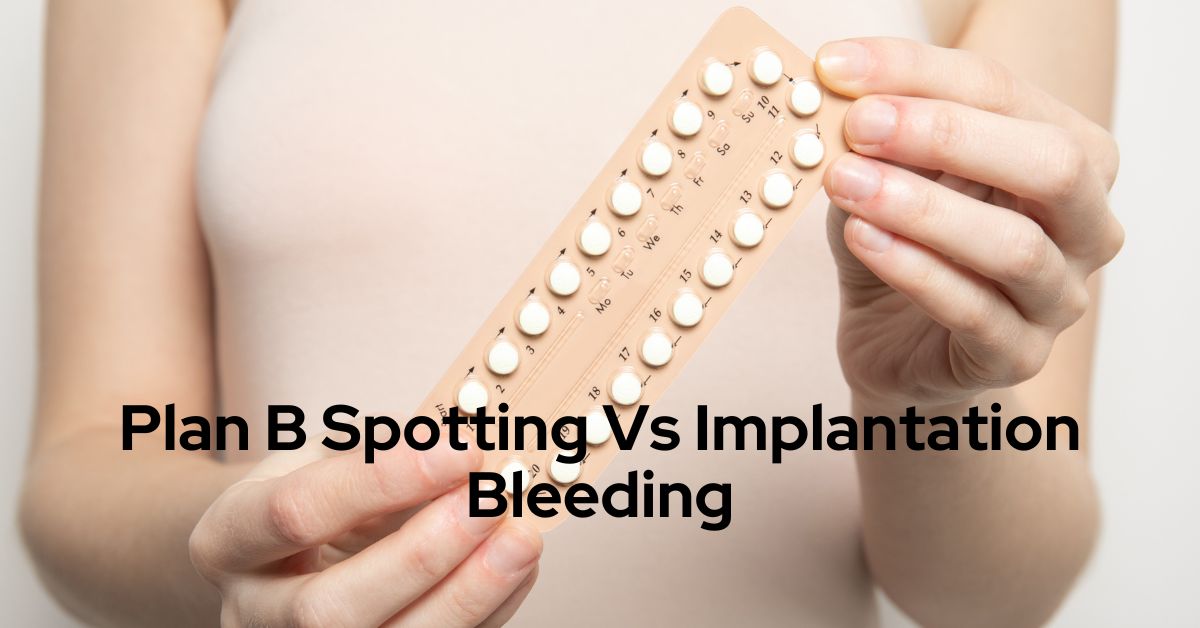Introduction
Spotting and Implantation bleeding are types of vaginal bleeding that are often confused because of the intensity of symptoms and their occurrence times that coincides with periods.
Menstruation or periods is the regular discharge of blood coupled with mucosal tissue from the inner lining of the uterus that ruptures when fertilization does not occur. Fertilization or impregnation is the process in which the male sperm fuses with the female egg to form the nucleus for the fetus.
To prevent the process of fertilization and subsequent pregnancy, healthcare professionals advise several fertility control measures referred to as contraception that, in the process of implementation, give rise to mild vaginal bleeding or spotting unrelated to periods.
Plan B Spotting and Implantation Bleeding are terms related to the cycle of birth control and pregnancy that you should know if you are unsure about your pregnancy status.
Plan B Spotting
Plan B Spotting is the light bleeding or spotting experienced by people taking the plan B contraceptive pill. Plan B, or Levonorgestrel, is an emergency contraceptive pill used after unprotected sex to prevent pregnancy. Plan B delays the release of the egg from the ovary or stops its release to prevent it from fertilizing with the sperm. Because of its effectiveness, the WHO refers to the drug as the gold standard in hormonal emergency contraception.
Before proceeding further, it is important to understand that contraceptive measures can be either in the form of
- pills that you take in your mouth to prevent pregnancy
- patches that you apply transdermally on the skin to release hormones for avoiding pregnancy
- Contraceptive injections that are injected into the body
- A vaginal ring that is placed inside the vagina for releasing hormones into the bloodstream
Out of these, pills are considered the most effective because of their 99% effectiveness and easy availability. Plan B is one such pill that regulates the levels of gonadotropin-releasing hormone from the hypothalamus and suppresses the Luteinizing Hormone that is vital for ovulation to carry out its job.
The LH hormone is also responsible for regulating the female’s menstrual cycle, and the dysregulation of the hormone results in unexpected changes in the menstrual cycle or Plan B spotting, as it is commonly referred to.
The WHO, Trials conducted by the WHO on 1.5mg Levonorgestrel or Plan B pill have established that.
- 30 % of users experience spotting within seven days of using the pill
- 13% experienced a more than seven days delay in menses
- 15% experienced spotting before their menses that lasted for 2.5 days
- Young women (under 20 years) and women with short cycle lengths at baseline (less than 26 days) experienced significantly lengthened cycles after taking the pill.
- Menstrual appearance during Plan B treatment is darker and stickier than before starting the treatment.
- Intermenstrual bleeding began as early as 8 hours after taking the pill and, on average, on the fourth day thereafter and was significantly more common for women who had intercourse early in the cycle, several days before their presumed date of ovulation.
- Cycle length was shortened by approximately one day for women who took EC in the preovulatory phase of the cycle and was lengthened by close to two days for women who took EC in the postovulatory phase of the cycle,
Multiple studies have established that the use of Levonorgestrel, in addition to delaying the ovulation period, delays the menstrual cycle by 12-18 days. The bleeding can be heavier or lighter, depending on the person’s systemic health. But usually, clots are not present. At the most, your period should take place within three weeks of taking the pill. If it does not occur, then you should get a pregnancy test done. The product information for Plan B pills has further advised taking a pregnancy test if your next menstrual period is five or more days late.
Most importantly, Plan BPill intake is associated with a significant but slight increase in menstrual cycle length, which makes it even more essential to take a pregnancy test if the onset of your next menses is delayed by more than five days after taking the pill.
Implantation Bleeding
Implantation bleeding is a small amount of light vaginal bleeding or spotting that can occur in early pregnancy due to the fertilized egg implanting in the uterus. It occurs within 14 days of fertilization and is often confused with periods. But it differs from regular periods in terms of duration, the intensity of bleeding and the colour of blood.
Implantation Bleeding is not an uncommon phenomenon, and according to the American Pregnancy Association experienced by 1/3rd of newly pregnant women worldwide. In a study conducted on 150 clinically pregnant women, 14 women (9%) experienced at least one day of vaginal bleeding during the first eight weeks of pregnancy. All pregnancies ended at live birth. Usually, implantation bleeding lasts for 2-3 days and is a relatively painless affair.
| Parameter | Implantation Bleeding | Periods |
| Duration | Few hours- 3 days | 3-7 days |
| Colour | Dark brownish to light pink | Pink, brown and reddish |
| Time of Occurrence | 10-14 days after conception | 28 days approx after the last menses |
| Pain | Mild without cramps | Moderate- intense with cramps |
The reasons for implantation bleeding are yet unclear. But researchers have hypothesized that it occurs due to the movement of the fertilized egg while it is attached to the inner lining of the uterus. Some of the linings are shed during this time resulting in mild bleeding referred to as implantation bleeding. In addition to implantation bleeding, some of the other symptoms that are observed during this period are
- Breast tenderness
- Nausea
- Mood changes
- Fatigue
- Food cravings and aversions
Because of the uncertainty of whether the bleeding is premenstrual, plan b induced, or because of pregnancy, several people feel inclined to take the pregnancy test during the time of implantation bleeding, which is unwise as it can lead to false-negative difficulties. It is best to wait a week after the spotting or the missed period to obtain accurate results.
The American Pregnancy Association advises waiting 11 days after conception for a blood test and 12-14 days for a urine test to be sure. The levels of HCG or Human Chorionic Gonadotropin also referred to as the pregnancy hormone, are tested in-lab in your blood and urine samples. An hCG level of less than five mIU/mL is considered negative for pregnancy, and above 25 mIU/mL is considered positive for pregnancy. Levels between 6 and 24 mIU/mL are considered grey areas and require a retest for accuracy.
Difference between Plan B Spotting and Implantation Bleeding
| PLAN B SPOTTING | IMPLANTATION BLEEDING | |
| Pregnancy Status | Negative | Positive |
| Colour | Mostly dark | Light pink -brownish |
| Clotting | It may or may not be present | Absent |
| Amount | mild-moderate | mild |
| Reason for occurrence | Hormonal imbalance because of the use of contraceptive | Shedding of the inner line of the uterus while the egg gets attached to it |
| phases | Preovulatory phase | Postovulatory phase |
| Symptoms | Discharge | Breast tenderness, nausea, headache |
| Lasting period | 5-6 days | 2-3 days |
| Associated Risks | Bleeding between periods or heavy menstrual bleeding | Miscarriage |
| Pain | Moderate | Negligible to mild |
Conclusion
Pregnancy is a risky affair and is associated with lifelong complications and mortality. Studies have shown that approximately 8% of all pregnancies involve complications that, if not treated, can impact the baby or the mother. Globally one in six women give birth before the age of 18, and pregnancy is one of the leading causes of death from 15-19 years in women. Even those above 35 are at risk of pregnancy-related complications with higher chances of miscarriage and stillbirths. Added by the increasing trends of risky behaviour and STDs, it is essential to have a clear idea about contraception and its risks for your safety.
Reference:
- americanpregnancy.org/pregnancy-symptoms/what-is-implantation-bleeding/
- data.unicef.org/topic/child-health/adolescent-health/#:~:text=Globally%20in%202021%2C%20an%20estimated,their%20education%2C%20livelihoods%20and%20health.
- www.themedicalcity.com/news/family-planning-basic-human-right
- www.ncbi.nlm.nih.gov/pmc/articles/PMC4313438/
- www.ncbi.nlm.nih.gov/pmc/articles/PMC1934349/
- www.ncbi.nlm.nih.gov/pmc/articles/PMC1934349/#R12







